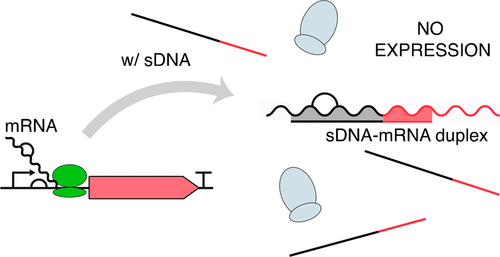Small Antisense DNA-Based Gene Silencing Enables Cell-Free Bacteriophage Manipulation and Genome Replication
K. Vogele et.al. 2021 ACS Synth. Biol. https://doi.org/10.1021/acssynbio.0c00402
12.02.2021
Kilian Vogele, Elisabeth Falgenhauer, Sophie von Schönberg, Friedrich C. Simmel, and Tobias Pirzer
ACS Synth. Biol. https://doi.org/10.1021/acssynbio.0c00402
Abstract
Cell-free systems allow interference with gene expression  processes without requiring elaborate genetic engineering procedures. This makes it ideally suited for rapid prototyping of synthetic biological parts. Inspired by nature’s strategies for the control of gene expression via short antisense RNA molecules, we here investigated the use of small DNA (sDNA) for translational inhibition in the context of cell-free protein expression. We designed sDNA molecules to be complementary to the ribosome binding site (RBS) and the downstream coding sequence of targeted mRNA molecules. Depending on sDNA concentration and the promoter used for transcription of the mRNA, this resulted in a reduction of gene expression of targeted genes by up to 50-fold. We applied the cell-free sDNA technique (CF-sDNA) to modulate cell-free gene expression from the native T7 phage genome by suppressing the production of the major capsid protein of the phage. This resulted in a reduced phage titer, but at the same time drastically improved cell-free replication of the phage genome, which we utilized to amplify the T7 genome by more than 15 000-fold in a droplet-based serial dilution experiment. Our simple antisense sDNA approach extends the possibilities to exert translational control in cell-free expression systems, which should prove useful for cell-free prototyping of native phage genomes and also cell-free phage manipulation.
processes without requiring elaborate genetic engineering procedures. This makes it ideally suited for rapid prototyping of synthetic biological parts. Inspired by nature’s strategies for the control of gene expression via short antisense RNA molecules, we here investigated the use of small DNA (sDNA) for translational inhibition in the context of cell-free protein expression. We designed sDNA molecules to be complementary to the ribosome binding site (RBS) and the downstream coding sequence of targeted mRNA molecules. Depending on sDNA concentration and the promoter used for transcription of the mRNA, this resulted in a reduction of gene expression of targeted genes by up to 50-fold. We applied the cell-free sDNA technique (CF-sDNA) to modulate cell-free gene expression from the native T7 phage genome by suppressing the production of the major capsid protein of the phage. This resulted in a reduced phage titer, but at the same time drastically improved cell-free replication of the phage genome, which we utilized to amplify the T7 genome by more than 15 000-fold in a droplet-based serial dilution experiment. Our simple antisense sDNA approach extends the possibilities to exert translational control in cell-free expression systems, which should prove useful for cell-free prototyping of native phage genomes and also cell-free phage manipulation.

